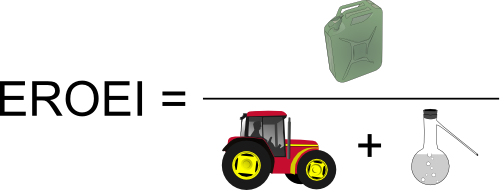EROEI – energy efficiency of fuel production
Posted by Krzysztof Lis on October 3, 2010
In many articles on this blog I used the term efficiency. It describes the ratio between the output power from any device (like an internal combustion engine) and the input to that device. For example, in internal combustion engine the output is the power transmitted via the shaft to the gearbox, while the input is the amount of energy stored in fuel, the heating value of the fuel. If we’re discussing electric engines, the output is the same, while the input is the amount of electrical power used by the engine while it is working.
When it comes to producing biofuels, or any fuels in general (even the ones derived from the petroleum), you use a similar factor, called EROEI. It is an abbreviation of Energy Return On Energy Invested. For a specific fuel it shows how much energy you obtain from this fuel when compared to the energy used to producing it.
For example, for the first generation biofuels (derived from corn, vegetable oil, etc.), the formula is the following:

The EROEI of bioethanol equals the amount of energy stored in the fuel (heating value) derived by energy used for production: farming and harvesting of the feedstock (corn), sending it to the biofuel factory, and the biofuel production (drying, fermentation, distillation). To the energy used for farming the corn you need to add the energy used to produce fertilizers, that are mostly produced with use of natural gas (that could be burned elsewhere).
EROEI for bioethanol is close to unity, so it means that from burning the ethanol we get as much energy as we use to produce it. You can increase this factor by using less energy for production (for example to use renewable energy like solar power to distill the ethanol) or decrease it (e.g. when you haul the corn for long distances).
EROEI for fuels like biogas or biodiesel is noticeably greater. You need far less energy to produce those fuels. Biogas doesn’t need the energy-thirsty distillation but only cleaning and compressing. Biodiesel also does not need distilattion, only the transesterification (the scientific name for the most important part of biodiesel production), that requires much less energy.
EROEI smaller than 1?
One might think that it is not reasonable to produce any fuel with EROEI smaller than one. It means that you get less energy from the fuel than you used to produce it. Wouldn’t it be better if we used the energy directly instead of the fuel, and not waste it to produce that fuel?
In some cases it will surely happen. For example, when you use some low quality energy or fuel to produce better quality fuel. Like coal, that is not a good fuel for cars can be used to produce gasoline alternatives in a group of processes called CtL (Coal to Liquid, like Fischer-Tropsch process).
In power and fuel sector noone really cares about indicators like EROEI, because not the energy balance but the money is the most important factor.
To make the formula I used cliparts downloaded from www.clker.com.
Leave a comment, and if you'd like your own picture to show up next to your comments, go get a gravatar!